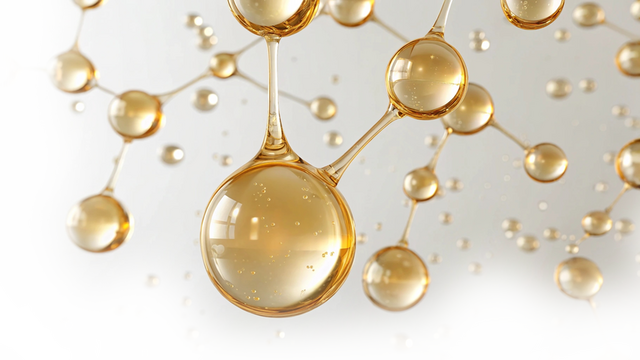
Panel discussion on...
Peptides
Peptides are small linear chains of amino-acids (AA) naturally present in the body (max 20 AA). Only very select endogenous peptides are involved in cell metabolism as upstream regulating messengers. It works like a key and a keyhole: specific peptide sequences trigger specific protein production. It means that only a select few peptides, with very specific amino acid sequences, can ‘control’ one or more protein’s production pathway.
The challenge for cosmetic use is to identify sequences of amino acids stimulating the production of molecules having a primary role in the maintenance of the skin properties. Most of the time, they are replicas of endogenous skin peptide fragments and mimic their action. To a certain extent peptides can be considered as ‘natural’ active ingredients thanks to their BIOMIMETIC ACTION.
Many peptides have been developed and tested for cosmetic purpose with a wide variety of functional claims beyond anti-ageing: eye care (anti dark circles and puffiness), lash care, lip care (plumping), hair care (counteracting loss and greying), body care (stretch marks), and more recently skin microbiome balance, pollution damage fighting (blue light), radiance (glass skin).
With peptides there are always more innovations in store! First, as just mentioned with regards to applications. Peptides being involved in natural skin metabolisms they can answer all beauty concerns. As long as appropriate tests are made to support them, many claims can be made.
Consumer perception of peptides is, unfortunately, that peptides are not sustainable because they are synthetic. However, chemically synthesized peptides are still made up of short chains of amino acids, elements naturally present in the human body and the environment, thus bringing nothing foreign to those ecosystems.
Most of the time their natural origin index according to the ISO 16128 standard is close to 100%. Moreover, the use of solvents that are harmful for people (like CMRs) and the planet (I.E. TFAs) for chemical synthesis of peptides has been drastically reduced over the last 6-7 years as well as the consumption of solvents overall (for Croda Beauty Actives the reduction reaches 86% for the last 6 years). Progress in the reduction of energy consumption and in waste management is also continuously made. Several research projects are on-going to chemically produce peptides more rapidly, with always less solvents (including water), with higher yields (100% purity). It is based on hybrid systems taking the best of the well-known liquid and solid processing technologies. Peptides of natural origin are another option to meet the need for both effective active ingredients and that sense of “naturalness” consumers look for. Here, the challenge is to be able to set-up protocols that guarantee reproducibility from batch to batch with a specific molecule characterization and purity (and not a blend of molecules that can include allergens). Then, once the purified molecule is obtained the peptide is as efficient as a synthetic analog.
Some peptides include a palmitic chain to enable their bioavailability. The palm derivatives used in low amounts to produce these peptides are RSPO (Roundtable on Sustainable Palm Oil) certified according to Mass Balance (MB) supply chain model. This is another example of bringing sustainability in peptide manufacturing.
Very avant-garde development programs will allow, in the near future, to manufacture peptides without resorting to solvents via synthetic biotechnology, in particular from algae. Synthetic biology is a multi-disciplinary field of biotechnology that combines biology, bioinformatics and engineering to build and develop biological systems that do not exist in nature, or to reconstruct existing systems by modifying them. This novel approach allows to develop production alternatives for molecules, like peptides, that may have been traditionally manufactured using particular chemistries that may have relied on solvents, catalysts or environmentally unfriendly materials. Synthetic biology also makes it possible to improve some manufacturing processes in terms of time savings, yields and therefore reducing consumption and costs.
Sustainability efforts are put on peptide’s manufacturing mode because once obtained they are safe and stable molecules, easy to formulate. That’s the reason why they are so appreciated, unlike other hero cosmetic ingredients like retinol or vitamins which are prone to degradation and toxicity. Furthermore, benchmarks between peptide efficacy and vitamin C or retinol in fighting signs of ageing are often conducted and for some of them, like the market reference Palmitoyl Pentapeptide-4*, peptide is more efficient. The benefits of encapsulation are known for retinol and vitamin C, reducing their degradation and sensitization. Peptides do not present similar side effects and are more tolerable by the different skin types, however these molecules are also benefited by the control release and target delivery.
Indeed, peptides can promote benefits to different layers of the skin. Delivering them to the correct target is a challenge that can be answered thanks to innovative association to delivery systems. These delivery systems allow peptides to increase stability, effectiveness and target specific skin layers. For example, peptide that has epidermis as site of action can be delivered using novel lipid capsules. Innovative approaches vary in terms of benefit given by the delivery systems. Today we have available lipid delivery systems that are natural derived, biodegradable and highly stable.
Older delivery systems like liposomes are sensible to surfactants and are usually unstable in emulsions. The last generation of lipid systems, consisting in a central oil core surrounded by a mixture of lipids and waxes circumvent this issue and facilitate the incorporation of the peptides in final formulations.
Delivering peptides to the target in skin can be achieved with deep understanding of the biological effects of the molecule, as well as the physico-chemical characteristics. Unique and specific design of delivery system like submicron particles can allow protection and stabilization and at the same time control the release, increase the activity and reduce side effects.
Efficient, more and more sustainable, safe, biomimetic, easy to formulate, peptides belong to the future of cosmetics. Peptides are involved in so many metabolic pathways that the number of applications is tremendous. Combined with the fact that the 20 standard amino acids offer endless possibilities for peptide structures alone are endless, cosmetic scientists still have a lot of work ahead of them!
Panelists
References and notes
- *: Matrixyl®






































